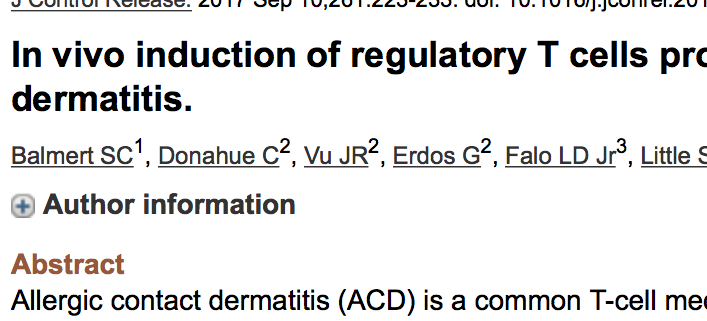Experimental T cell regulation in ACD – novel potential interventions
Original Article: Balmert SC, Donahue C, Vu JR, Erdos G, Falo LD Jr, Little SR. In vivo induction of regulatory T cells promotes allergen tolerance and suppresses allergic contact dermatitis. J Control Release. 2017 Sep 10; 261:223-233.
Reviewer: Calvin T Sung, BS. MSIII, University of California Riverside School of Medicine
- Allergic contact dermatitis (ACD) is a T-cell mediated inflammatory skin condition commonly treated with topical corticosteroids through nonspecific immunosuppression.
- The underlying immune hypersensitivity dysfunction can be addressed through identification and avoidance of the causative agent.
- Essentially, ACD results from an inbalance between immune suppressing T regulatory cells (Tregs) and the pro-inflammatory cells that are inappropriately responding to specific allergens.
- Immunologial chemical messengers, aka cytokines, (IL-2 and TGF-b1) and the antibiotic rapamycin can promote the expansion of Tregs to suppress the over active immune function underlying ACD.
- Microparticle polymers are notable large molecules that can carry and release IL-2, TGF-b1, and rapamycin.
- Balmert et al demonstarted that a Poly(ethylene glycol)-poly(lactic-co-glycolic acid) microparticle (PEG-PLGA) had a faster release rate of IL-2, TGF-b1, and rapamycin compared to the original PLGA microparticle formulation previously described by Jhunjhunwala et al.1
- The cytokine and antibiotic releasing microparticle treatment was formulated as a subcutaneous injection and delivered experimentally to mice two days prior to topical and microneedle delivered allergen exposure (to induce sensitization).
- Microparticle treatment injections at the ear (where allergens were introduced) revealed the potential for increasing the number of local Tregs to dampen unwanted immune responses upon subsequent allergen exposure.
- Experiments demonstrated that microparticle treatment injections must be delivered locally near the site of allergen exposure (ear), whereas distal treatment (abdomen) failed to proliferate Tregs at the ear.
- Interestingly, abdominal microparticle treatments followed by allergen exposure is capable of eliciting a systemic hyporesponsiveness that significantly reduces ear swelling when exposed to subsequent allergen challenges without any local prophylaxis.
- This experimental data in mice suggests that prophylactic treatment during exposure and sensitization to a particular allergen could significantly suppresses immune dysfunction upon subsequent exposures anywhere on the body.
- Considering that PEG-PLGA microparticle treatments can induce specific Tregs to suppress specific allergen mediated response, this modality offers a promising translatable novel treatment concept that could be used to decrease immune reactivity to known allergens inducing dermatitis.
For original article please visit: https://www.ncbi.nlm.nih.gov/pubmed/28694031 or http://www.sciencedirect.com/science/article/pii/S0168365917307046?via%3Dihub



